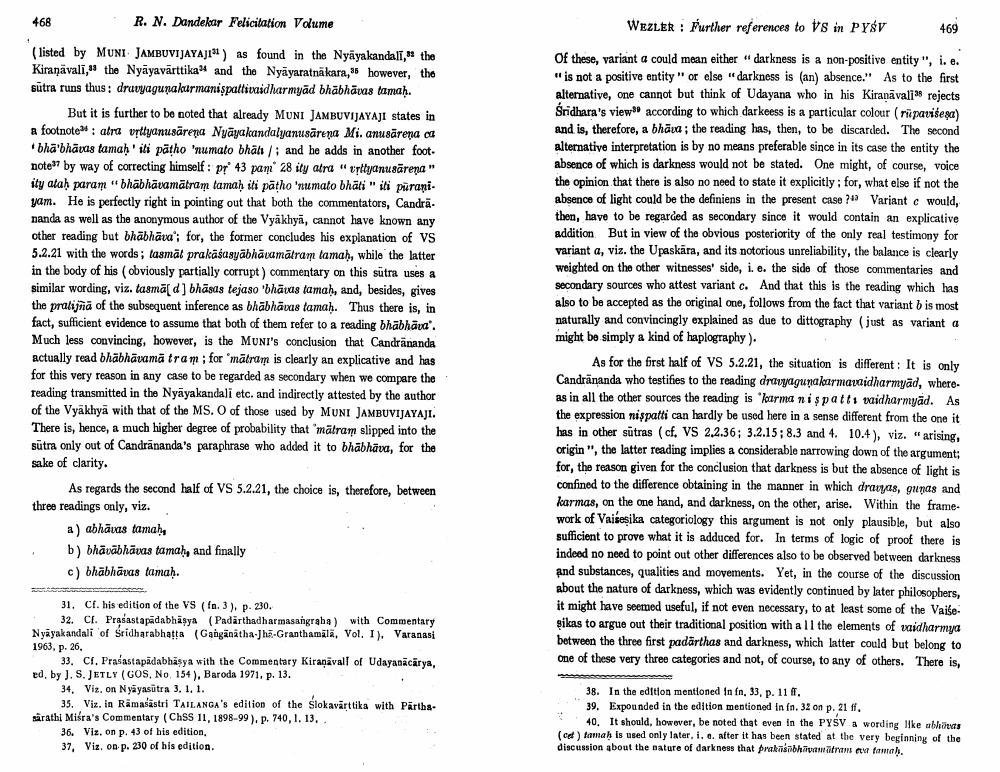Book Title: Further References To Vaisesika Sutra In Patanjala Yogasastra Vivarana Author(s): A Wezler Publisher: A Wezler View full book textPage 7
________________ 468 R. N. Dandekar Felicitation Volume (listed by MUNI JAMBUVIJAYAJI) as found in the Nyayakandali," the Kiranavali, the Nyayavärttika and the Nyayaratnakara, however, the sutra runs thus: dravyagunakarmaniṣpattivaidharmyād bhābhāvas tamaḥ. But it is further to be noted that already MUNI JAMBUVIJAYAJI states in a footnote: atra vṛttyanusärena Nyāyakandalyanusarena Mi. anusāreņa ca 'bha'bhāvas tamaḥ' iti patho 'numato bhats /; and he adds in another footnote37 by way of correcting himself: pr' 43 pan 28 ity atra "vṛttyanusāreņa" ity ataḥ param "bhabhavamatram tamaḥ iti patho 'numato bhati" iti puraniyam. He is perfectly right in pointing out that both the commentators, Candra. nanda as well as the anonymous author of the Vyakhya, cannot have known any other reading but bhabhava"; for, the former concludes his explanation of VS 5.2.21 with the words; tasmat prakāśasyabhavamatram tamaḥ, while the latter in the body of his (obviously partially corrupt) commentary on this sutra uses a similar wording, viz. tasma[d] bhāsas tejaso 'bhavas tamaḥ, and, besides, gives the pratijna of the subsequent inference as bhābhāvas tamah. Thus there is, in fact, sufficient evidence to assume that both of them refer to a reading bhabhāva". Much less convincing, however, is the MUNI's conclusion that Candrananda actually read bhabhavamā tram; for 'matram is clearly an explicative and has for this very reason in any case to be regarded as secondary when we compare the reading transmitted in the Nyayakandali etc. and indirectly attested by the author of the Vyakhya with that of the MS. O of those used by MUNI JAMBUVIJAYAJI. There is, hence, a much higher degree of probability that "matram slipped into the sutra only out of Candrananda's paraphrase who added it to bhabhāva, for the sake of clarity. As regards the second half of VS 5.2.21, the choice is, therefore, between three readings only, viz. a) abhāvas tamaḥ, b) bhāvābhāvas tamaḥ, and finally c) bhābhāvas tamaḥ. 31. Cf. his edition of the VS (fn. 3), p. 230. 32. Cf. Prasastapadabhäṣya (Padarthadharmasangraha) with Commentary Nyayakandali of Sridharabhaṭṭa (Ganganatha-Jha-Granthamälä, Vol. 1), Varanasi 1963, p. 26. 33. Cf. Prasastapadabhāṣya with the Commentary Kiranavall of Udayanācārya, ed, by J. S. JETLY (GOS, No. 154), Baroda 1971, p. 13. 34. Viz. on Nyāyasutra 3. 1. 1. 35. Viz. in Ramasastri TAILANGA's edition of the Slokaväṛttika with Pärthasarathi Misra's Commentary (ChSS 11, 1898-99), p. 740, 1. 13.. 36. Viz. on p. 43 of his edition, 37, Viz. on p. 230 of his edition. WEZLER: Further references to VS in PYSV 469 Of these, variant a could mean either "darkness is a non-positive entity", i. e. " is not a positive entity" or else "darkness is (an) absence." As to the first alternative, one cannot but think of Udayana who in his Kiranavali rejects Śridhara's view according to which darkeess is a particular colour (ripavišesa) and is, therefore, a bhava; the reading has, then, to be discarded. The second alternative interpretation is by no means preferable since in its case the entity the absence of which is darkness would not be stated. One might, of course, voice the opinion that there is also no need to state it explicitly; for, what else if not the absence of light could be the definiens in the present case ? Variant c would, then, have to be regarded as secondary since it would contain an explicative addition. But in view of the obvious posteriority of the only real testimony for variant a, viz. the Upaskāra, and its notorious unreliability, the balance is clearly weighted on the other witnesses' side, i. e. the side of those commentaries and secondary sources who attest variant c. And that this is the reading which has also to be accepted as the original one, follows from the fact that variant b is most naturally and convincingly explained as due to dittography (just as variant a might be simply a kind of haplography). As for the first half of VS 5.2.21, the situation is different: It is only Candrananda who testifies to the reading dravyagunakarmavaidharmyad, whereas in all the other sources the reading is "karma ni spatts vaidharmyad. As the expression nispatti can hardly be used here in a sense different from the one it has in other sutras (cf. VS 2.2.36; 3.2.15; 8.3 and 4. 10.4), viz. "arising, origin", the latter reading implies a considerable narrowing down of the argument; for, the reason given for the conclusion that darkness is but the absence of light is confined to the difference obtaining in the manner in which dravyas, gunas and karmas, on the one hand, and darkness, on the other, arise. Within the framework of Vaisesika categoriology this argument is not only plausible, but also sufficient to prove what it is adduced for. In terms of logic of proof there is indeed no need to point out other differences also to be observed between darkness and substances, qualities and movements. Yet, in the course of the discussion about the nature of darkness, which was evidently continued by later philosophers, it might have seemed useful, if not even necessary, to at least some of the Vaiseşikas to argue out their traditional position with a 11 the elements of vaidharmya between the three first padärthas and darkness, which latter could but belong to one of these very three categories and not, of course, to any of others. There is, 38. In the edition mentioned in fn, 33, p. 11 ff. 39. Expounded in the edition mentioned in fn. 32 on p. 21 ff. 40. It should, however, be noted that even in the PYSV a wording like abhövas (cet) tamah is used only later, i. e. after it has been stated at the very beginning of the discussion about the nature of darkness that prakasabhavamitrans eva tamaḥ,Page Navigation
1 ... 5 6 7 8 9
